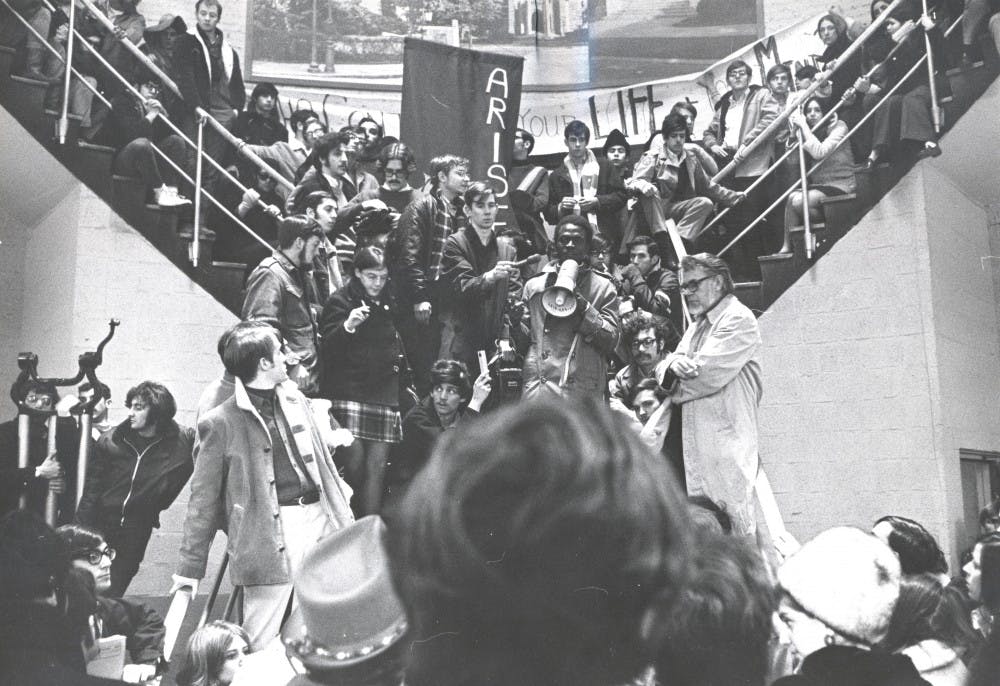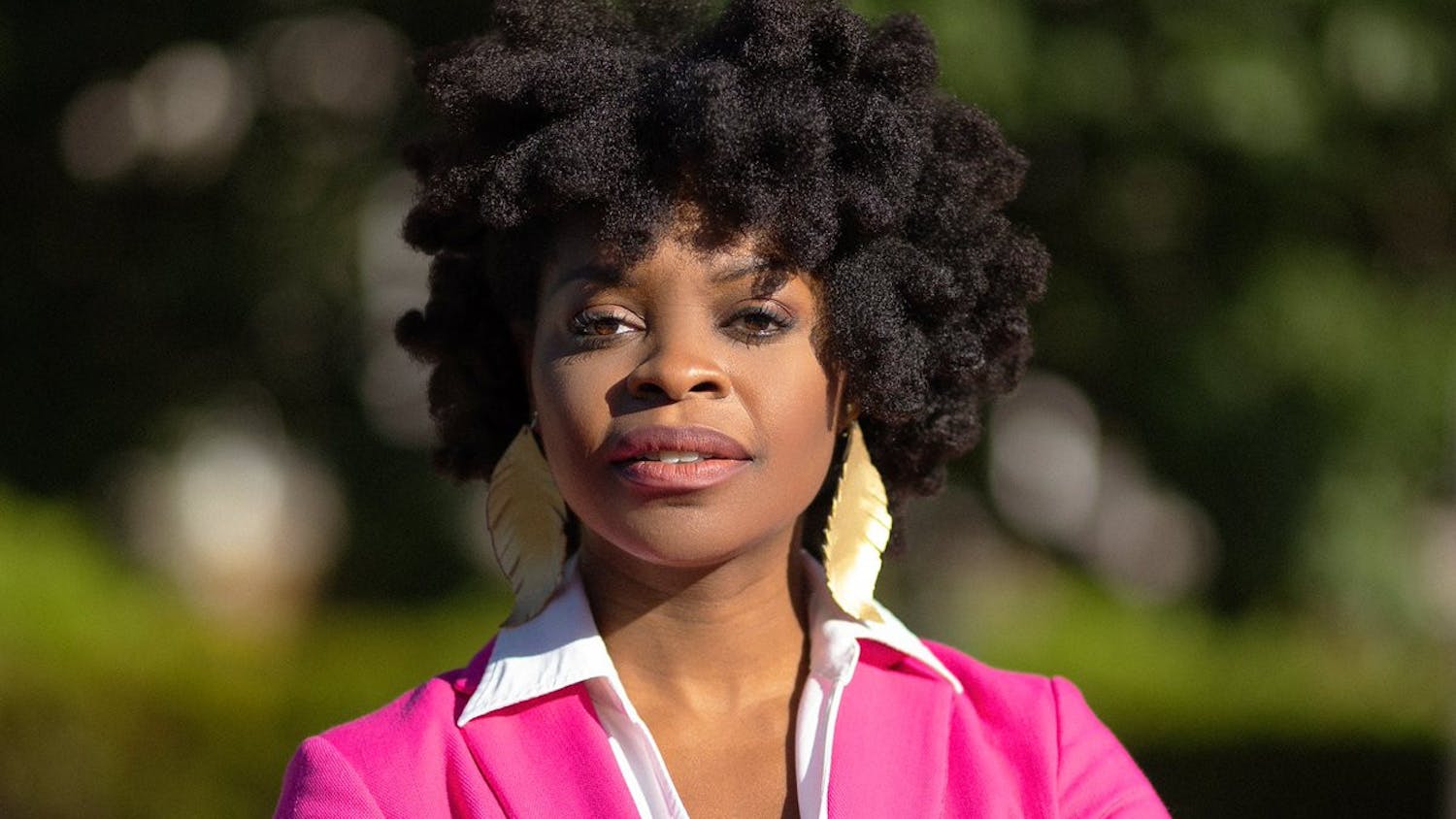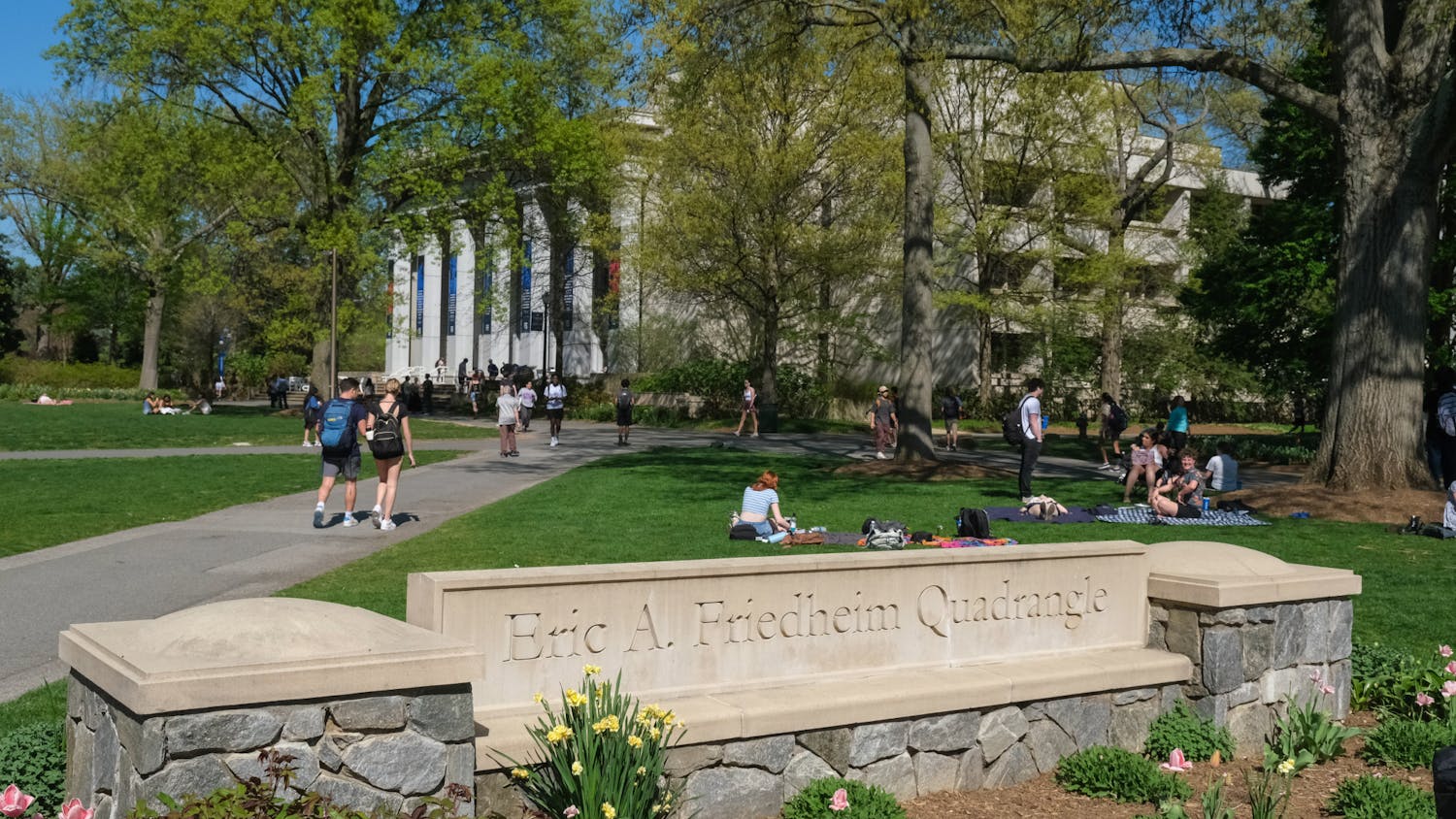This article originally appeared in The Eagle's special edition on Oct. 21.
Ma’at Sargeant and Jada Bell, roommates, leaders in the Black Student Alliance and organizers of the #SolidaritywithourSisters Rally, stood on the steps of the Mary Graydon Center in front of hundreds of students, faculty, and staff on Sept. 19. The two spoke of their frustration with the continued lack of action from University administrators regarding racism on AU’s campus.
“You can write us emails all day long, you can plan steps all day long, but we need them implemented,” Sargeant said. “We want action, less talk.”
Sargeant and Bell are among many students of color at AU who feel that the University campus is not a safe, inclusive or racially diverse community, especially following recent racially charged incidents on campus. Many of these students are frustrated that the administration has not taken concrete actions to respond to student outcry about the need for improved classroom and campus climates, including demands for more faculty of color and the development of curriculum focused on the African or black experience.
These demands however are not new. An Eagle investigation using the paper’s archives found that many of the demands and frustrations of today echo the sentiments of students dating all the way back to the late 1960s.
A push for change over 40 years ago
Following the assassination of Dr. Martin Luther King Jr. in 1968, three AU students, Walker “Moose” Foster, Joseph Harris and Bert Coppack, helped found the Organization of African and Afro-American Students at The American University (OASATAU). The organization’s aim was to improve the campus climate for black students at a predominately white university.
The establishment of OASATAU and black activism corresponded with the growing Black Power movement spreading across the United States at the time. In institutions of higher education, black students were embracing blackness more than ever before, according to Dr. Ibram X. Kendi, an assistant professor of African American history at the University of Florida, and author of “The Black Campus Movement: Black Students and Racial Reconstitution of Higher Education.” Kendi also recently spoke at AU on Oct. 13 to discuss his new book, “Stamped From The Beginning, The Definitive History of Racist Ideas in America”.
“In the 1960s black students were all about black is beautiful, all about black unity, and black solidarity and black self-love and valuing African American culture and African culture,” Kendi said. “They embraced blackness more than any other group of students at historically white campuses had before in history.”
Dr. Joseph Harris, a 1970 AU alumni and one of the leaders in the establishment of OASATAU, said that his activism and experience as a black student at AU was a continuous learning experience.
“We were becoming more aware of our own identities as black students as my college years and college education evolved,” Harris said. “I think we had a reasonably good experience as an organization with the University. The things we were trying to do were an education for [the administration] and an education for us.”
Tracing the history and mission of OASATAU
“I felt like a fly in buttermilk,” 19-year-old Walker “Moose” Foster, a leader in OASATAU, told The Eagle in March 1968. “I was stranded in affluent Spring Valley. The only Negroes we saw here were janitors.”
In a statement about its purpose and mission, OASATAU detailed the departments within the organization, which included a social and cultural division, a political and public relations division and a communications division that oversaw the group’s own newspaper, called UHURU, based off the socialist movement UHURU, which focused on the theory of African Internationalism.
“It shall be the duty of this division to provide the black community with vehicles of media communications designed to inform, educate and entertain,” the statement read.
In April 1969, The Eagle reported that students in OASATAU presented demands for change to then President George Williams, including the creation of a black ecological studies program, educational programs for black staff, implementation of Afro-American history week, scholarship funds for black students, active recruiting of more black staff and faculty and the hiring of a dean to oversee black student affairs and a black coeducational floor.
In response to OASATAU’s demands for curriculum changes, in 1968 the University created four courses related to African American studies; however, Foster argued that the courses were not entirely interdisciplinary and were not relevant to black students. In a September 1968 Eagle article, he expressed doubt that the courses would remain a part of the University curriculum in the long term.
“We don’t want one-shot ornaments,” Foster told The Eagle. “Black courses must be a functioning part of the departments at AU.”
The response from AU administrators at the time was mixed. President Williams acknowledged and legitimized the demands, and supported some of them, such as black faculty recruitment and the establishment of the Black Ecological Studies program. Others though, such as OASATAU’s efforts to create an interdisciplinary Black Studies program, were not supported by the administration.
OASATAU members also began to take action for themselves. With a research grant provided by the University, they outlined and proposed plans for the creation of a Black Studies program. However, when the plan was presented to the Faculty Senate in the fall of 1969, it was tabled and no funding was offered.
“The paper was promptly tabled and listed as just another item on the agenda. The University wanted a bargain basement Black Studies program--a catalogue of the university’s courses under the heading “Black Studies,” Foster told The Eagle in 1971 in response to the Faculty Senate’s decision.
OASATAU worked with the Office of Admission to recruit students locally in D.C.’s predominately black public high schools. By 1971, largely in response to OASATAU’s efforts, the University hired a full time director to coordinate black student recruitment and started the Frederick Douglass Scholarship to recruit local D.C. high school students. The scholarship program continues today as a full-ride scholarship for incoming freshmen, and gives preference to first generation students and students that are committed to working in communities of color in the U.S., according to the program’s website.
“I know the University recruited [alum] Bush Bell to address issues at the administrative level as it related to people of color; in the chaplaincy an African American spiritual leader was recruited,” Harris said, referring to some of the changes implemented by the University at the time. “There were a couple of African American history courses that evolved while we were there and the Frederick Douglass program came into being which was a major commitment. There was a move to diversity broadening.”
Different time, same issues
Back in the late 1960s, University administrators responded with action to student pressure over increasing inclusivity on campus, but as activism waned, so did administrator commitment.
Despite that, sentiments of progressive diversity and inclusion remained, and many students, such as Sargeant, are still pushing for change today.
“SIS initially drew me to AU and the diversity and inclusion aspect of AU. I really thought this was going to be an inclusive campus and one where I could make my home. That is why I initially came,” Sargeant said. When she arrived on campus, however, her perceptions changed. “I was shocked by how white it was.”
The incident in Anderson Hall in September sparked instant outcry and frustration from many students regarding the handling of the situation by administrators, but it also brought past issues of race and racial insensitivity on AU’s campus to the forefront.
Kendi said that many of the problems raised by today’s black student activists reflect similar sentiments as the late 1960s because while institutions may respond to student pressure at the time, administrative efforts for change decline as activism dies down.
“Just like you can initiate a new program for recruiting new black students or black faculty, so too can you discontinue that program,” Kendi said. “In many cases when student pressure and protest declined by the mid-1970s, administrators discontinued many of the programs initiated in the late 1960s, whether it was recruitment programs or institutional programs like black studies.”
Stalled progress
A dropoff in inclusive recruitment efforts is evident in the enrollment demographics at AU in the early 1980s, when there was a decline in both student and faculty of color at AU. The American University Academic Data Reference Book, a publication of The Office of Institutional Research, reported that 11 percent of full time undergraduates were black in 1980. In 1982, black students composed 9.5 percent of full time undergraduates. By 1983, school records show that there were just 272 full-time undergraduate black students, around 7.4 percent of 3,685 total full time undergraduate students.
The number of black professors at AU fell below the national average during this time as well. In 1983, six of AU’s 394 full-time faculty members were black, making up approximately 1.5 percent of the faculty, versus the national average of approximately 4.4 percent full time faculty.
In April 1987, OASATAU rewrote its constiution to expand the organization and reach more students, becoming the OASATAU-Black Student Union.
In response to dropping enrollment numbers among black students, Scott Roberts, a coordinator of the OASATAU-Black Student Union at the time, said he felt the change was due to “a lack of communication between student needs and administrative action.” Roberts told the Eagle, “There has been a slow erosion of any gains that we made.”
In 1977, two years before he arrived on AU’s campus, Phillip A. Lattimore III, a 1983 alumni, a leader in OASATAU and Editor-in-Chief of UHURU for two years, the University had more students of color than ever before. By 1983 when he left, the numbers had dropped significantly. The black student population was at approximately 4 percent.
“The drop in black student population was very visible on campus,” Lattimore said. “The University made no commitment at the time, institutionally, to try to stop the bleeding of students leaving the campus and increasing its efforts to bring minority students on campus. So we began to urge the University to take action.”
While a full-time law student at the Washington College of Law, Lattimore began working part-time for the University to collect more institutional data between 1984 and 1986. The research proved that there were significant losses of black students on campus. In response, the administration instituted the Office of Minority Affairs.
“The research validated everything we were concerned about.The University and administrators responded and did a really good job of acting,” Lattimore said. “My take on it is, that the University over the past 10 years really dropped the ball.”
Today, while the demographics of AU’s campus have changed, black students still make up only a small percentage of the population. The American University Academic Data Reference Book’s most recent available records show that in the fall of 2015, there were 473 black/African American full-time undergraduate students, making up 6.7 percent of the total number of students, whereas 58.2 percent, or 4,092 students, were white.
For the 2015-2016 academic year, the University's Academic Data Reference Book reported that 75.5 percent of faculty were white, whereas 4.8 percent were African American. In the 2014-2015 academic year, 76.95 percent were white faculty and 4.42 percent were African American.
Moving forward
As students push for change on campus today, AU’s NAACP chapter made several demands at a Sept. 18 town hall meeting that chapter President Elisa Martinez and Vice President Sydney Young felt could be acted on immediately, including mandatory racial sensitivity trainings at freshman orientation, additional questions at the end of course evaluations regarding the racial climate of the classroom and the racial sensitivity of professors.
“I think it is clear that they are listening, I would be interested to hear if [they] follow through with the demands,” Martinez said. “It’s one thing to say it, but it's another thing to do it.”
Another major demand by student activists now and over the past 45 years has been the need to hire more faculty of color. Senior Vice Provost Mary Clark, who oversees the hiring of faculty, said that she acknowledges that students want to see more diversity in AU’s faculty, and that it is something the administration is working to do.
“I am mindful that our student body is more diverse than our faculty body and I do think it is important to diversify our faculty,” Clark said. “I think there is work to do in the curriculum. There is a new Afro-American studies program [and] a new collaborative on critical race theory and gender theory but there is more to be done. Part of our efforts this year in hiring more diverse faculty is looking to see if we can diversify curriculum, whether in international service, public affairs or communications.”
AU’s role in today’s national conversation
Across the country and at AU, students are pressuring university administrators to institutionalize more programs and efforts to support and empower black students.
“The Black Lives Matter movement is almost a grandchild of the Black Power movement,” Kendi said. “It is the case that racial insensitivity is pervasive across the country. To create an idea that it is the same everywhere, that there is nothing we can do, doesn't take into account the fact that there are other places and campuses that are doing it better.”
Though AU administrators have committed to change, and student activists continue to pressure them to act, there is a discrepancy between students’ and administrators’ thoughts on the conversations occurring on campus in relation to racial tensions and violence across the country.
Both Martinez and Sargeant noted that administrators at the University-hosted town hall meeting, as well as in memos sent to the campus community, expressed that what was happening on AU’s campus was reflective of the country’s currently troubled racial climate.
“It’s true, we are dealing with acts of police brutality every day, we as a country are dealing with numerous issues illustrating institutional racism in this country that is rampant. But we each pay $60,000 a year to come to this institution,” Martinez said. “I do realize that these issues affect the University, but we are better than that. We come here to be better than that. AU prides itself on being a diverse and inclusive community. ‘We are dealing with these issues as a country,’ is not an excuse.”
Assistant Vice President of Campus Life Fanta Aw, a critical race theorist who herself was a student at AU in the 1970s, said that the University is trying to determine the best ways to better the campus community in the future.
“This is 2016, why are we having the same conversations that happened during the Civil Rights Movements and after?” Aw said. “A big part of the reason is because, as a society, we struggle so much to really critically examine race relations and the history of it to then be able to know how we actually move forward.”
Lattimore said that at the time of the most recent incidents, he received a call from AU to inform him of the news. The news disappointed him, to hear that such acts continue to occur, and that the University has not maintained past activists’ work and change.
“The University can’t forget that there is a responsibility to keep efforts going, or else in 10 to 20 years these incidents will come back again and all of the hard work in the past would have been in vain,” Lattimore said. “And that to me is what’s important. Its emotionally tiring, everyone fought those battles in the 1960s and 80s and just to see it happen again is exhausting.”





